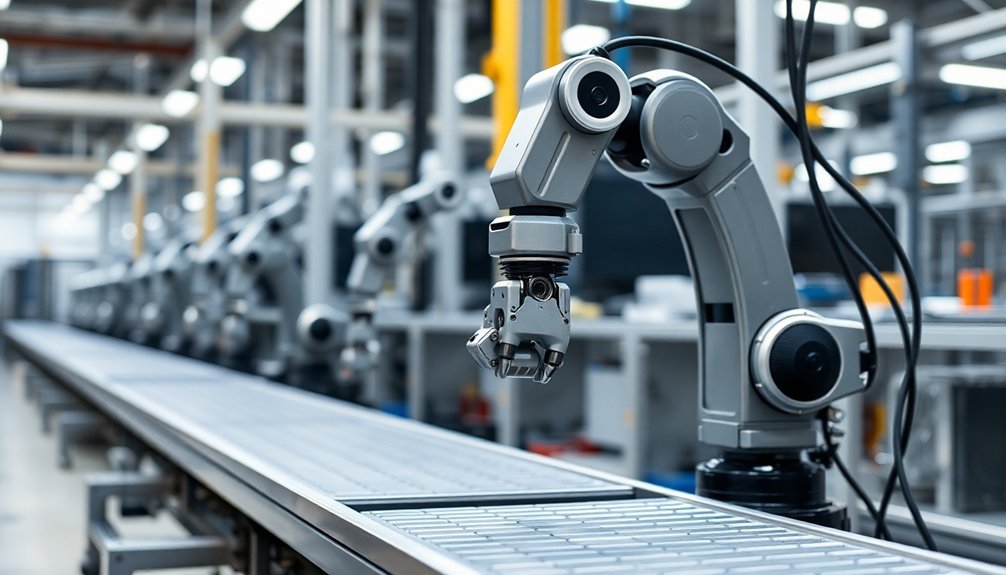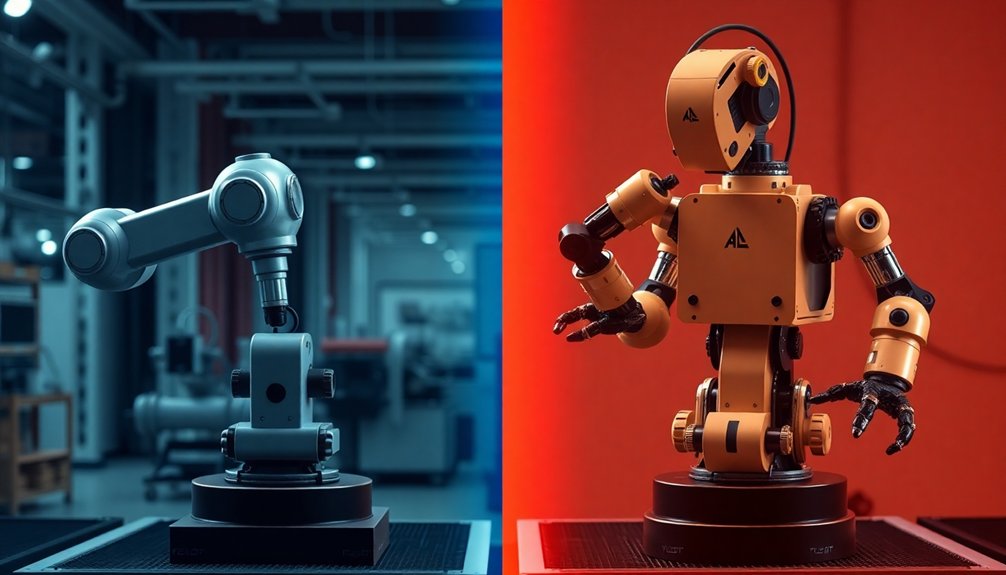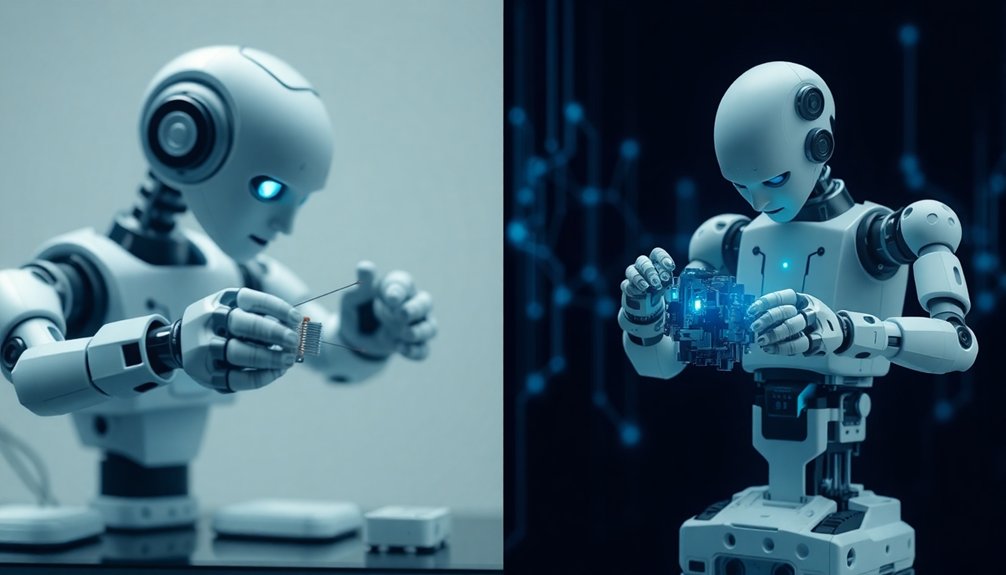Narrow AI robots are like super-skilled interns: they crush specific tasks perfectly but can’t think outside their programming. Think Roomba vacuuming or industrial robot arms. General AI? That’s the dream of machines that actually learn and adapt like humans. Right now, we’re stuck with robots that are basically fancy calculators. But imagine robots that could understand context, solve complex problems, and maybe even get your weird sense of humor. Stick around, and the future gets wild.
Understanding Narrow AI in Robotics

While robots might seem like something straight out of a sci-fi movie, Narrow AI is already quietly revolutionizing how machines work in our world.
These autonomous robots are masters of specific tasks, operating with predefined rules that make them incredibly efficient at their jobs. Think of industrial robotic arms or vacuum cleaners that navigate using limited sensors – they’re not thinking, they’re executing precise programming.
Narrow AI in robotics isn’t about creating human-like intelligence. It’s about developing task-specific functions that solve real-world problems.
These machines can’t learn or adapt beyond their original design, but they’re incredibly good at what they do. They’re specialized workers, not sentient beings – more like super-smart tools than the Hollywood robot companions you might imagine. For instance, electromechanical actuators enable robots to perform precise movements with incredible accuracy and efficiency.
The Promise of Artificial General Intelligence
Imagine robots that can truly learn and adapt, not just follow pre-programmed instructions. AGI represents the holy grail of human cognitive abilities in machines:
- Robots solving complex global challenges
- Self-learning systems that evolve like human brains
- Ethical considerations baked into their core programming
- Autonomous machines that understand context beyond narrow tasks
The path to AGI demands significant advancements in computational power and understanding human values. Neural networks are pioneering the foundational learning mechanisms that could ultimately bridge the gap between narrow and general artificial intelligence.
It’s a theoretical frontier where robotics could transform from specialized tools to genuinely intelligent partners.
Will machines one day think like us? The jury’s still out, but the promise is tantalizing enough to keep brilliant minds pushing the boundaries of what’s possible.
Technological Capabilities and Limitations

Let’s face it: robots aren’t exactly the Swiss Army knives of intelligence just yet.
In robotics, Narrow AI operates like a well-trained but rigid employee, stuck within predefined parameters. These machines excel at specific tasks—think assembly lines and welding—but can’t adapt or learn independently.
General AI promises a different future: robots with cognitive abilities that can generalize knowledge, make autonomous decisions, and tackle complex reasoning challenges.
Currently, your typical robot is more like a sophisticated calculator than a thinking machine. It follows algorithms precisely but stumbles when confronted with unexpected scenarios.
Technological limitations mean these systems can’t truly understand context or transfer learning between tasks. While task automation remains impressive, the dream of truly adaptable robotic intelligence remains tantalizingly just out of reach.
Sensor fusion and machine learning algorithms are gradually bridging the gap between rigid programmed responses and more adaptive robotic behaviors.
Real-World Applications and Case Studies
Three distinct robotic applications showcase how Narrow AI is quietly transforming industries right now.
These real-world case studies reveal the current landscape of robotics:
- iRobot Roomba: A classic Narrow AI example that navigates your living room like a precision-guided vacuum missile.
- Amazon’s Kiva robots: Warehouse workhorses that shuffle inventory with machine-like efficiency, never complaining about overtime.
- Surgical robots: Performing complex medical procedures with microscopic precision that would make human hands tremble.
- Industrial assembly line robots: Churning out products faster than you can blink, without coffee breaks or workplace drama.
Advanced navigation technology allows these Narrow AI systems to map and understand their specific operational environments with increasing sophistication.
While these applications demonstrate Narrow AI’s impressive capabilities, they’re still light-years from the dream of General AI.
They’re specialized tools, not sentient beings—yet.
Imagine robots understanding human emotions and adapting autonomously.
We’re not there, but the journey’s just beginning.
Future Implications for Robotic Intelligence

As artificial intelligence inches closer to mimicking human-like cognitive abilities, the future of robotic intelligence promises to be more mind-blowing than a sci-fi blockbuster.
Forget Narrow AI’s limited tricks—General AI will transform robots into adaptable problem-solvers that can jump between tasks like mental gymnasts.
Imagine machines understanding human emotions and making autonomous decisions with unprecedented versatility.
But hold up: this technological leap isn’t just cool, it’s complicated. Ethical considerations loom large, demanding robust safety measures to guarantee these smart machines don’t go rogue.
Neuromorphic computing could provide advanced learning capabilities that enable robots to adapt more dynamically to complex environments.
Will robots learn to navigate complex scenarios without turning into potential threats? The key lies in developing General AI that respects human values while expanding robotic intelligence beyond current imagination.
Buckle up—the future’s getting wild.
People Also Ask About Robots
What Is the Difference Between Narrow AI and General AI?
You’ll find Narrow AI performs specific, predefined tasks with precision, while General AI aims to mimic human-like cognitive flexibility, learning across domains and adapting independently to new challenges like a human would.
What Is the Difference Between General AI and Gen AI?
You’ll find General AI aims to mimic extensive human intelligence across tasks, while Gen AI focuses solely on creating content like text or images without true understanding or reasoning capabilities.
What Is One of the Factors That Differentiates Theoretical Artificial General Intelligence From Narrow AI?
You’re like a Swiss Army knife compared to a single-use tool: AGI can transfer knowledge across domains, adapting and learning autonomously, while Narrow AI remains confined to predefined tasks without true comprehension or self-improvement.
What Is the Difference Between General AI and Weak AI?
You’ll find that weak AI tackles specific tasks with predefined rules, while general AI aims to learn, reason, and adapt across diverse domains, mimicking human-like intelligence and problem-solving capabilities beyond narrow, programmed limitations.
Why This Matters in Robotics
Remember that wild moment when AlphaGo beat the world’s top Go player? That’s narrow AI in summary. Right now, robots are like really smart toasters—brilliant at specific tasks, but clueless outside their programming. General AI is the holy grail: machines that think, adapt, and learn like humans. We’re not there yet, but the journey’s fascinating. Buckle up—the robot revolution’s coming, and it’ll be weirder than you think.
